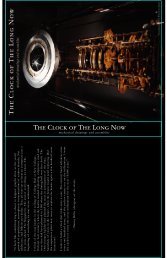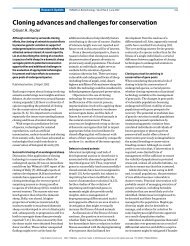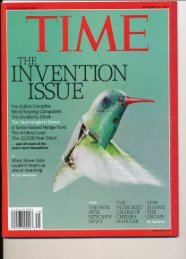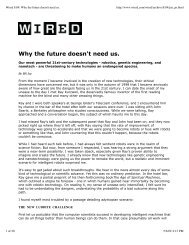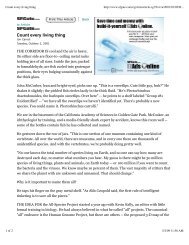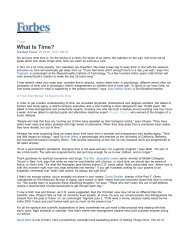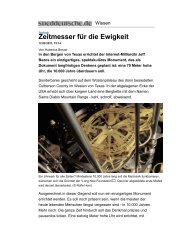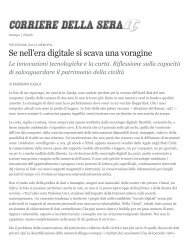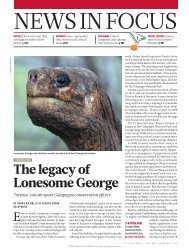PDF Download - Long Now Foundation
PDF Download - Long Now Foundation
PDF Download - Long Now Foundation
You also want an ePaper? Increase the reach of your titles
YUMPU automatically turns print PDFs into web optimized ePapers that Google loves.
Engineering the 10 000-Year Clock - IEEE Spectrum http://spectrum.ieee.org/geek-life/profiles/engineering-the-10-0...<br />
tunnel's end [model shown<br />
here]. They'll climb the spiral<br />
steps until they reach a<br />
platform, where they'll wind<br />
the clock.<br />
Selecting the right materials is only one piece of the puzzle. There's also the matter of<br />
keeping the clock ticking and telling the correct time. Because, really, what's the point of a<br />
clock if it can't tell time?<br />
To maintain the clock's accuracy, Hillis and Rose had to figure out a way to somehow sync<br />
their clock, buried deep within a mountain, with the outside world. In earlier designs, they considered a solar<br />
synchronizer: A beam of sunlight would pass through a slot in the top of the clock at noon, heating up and contracting a<br />
piece of nickel titanium shape-memory wire; the wire would act as a mechanical trigger, resetting any error that had crept<br />
into the timekeeping since the previous day.<br />
It's a clever idea, one of many the team has devised. In total, they have 10 U.S. patents on the clock, including the<br />
winding tower, the clock face, and the solar-triggering mechanism. "We're probably the only ones patenting weird clock<br />
esoterica," Rose says.<br />
The problem with memory wire, as with the use of electronics, was the lack of transparency. "Nickel titanium can last, but<br />
it's effectively a magic material," Rose says. "It would be difficult to replicate it in the future if someone needed to remake<br />
that part."<br />
Instead, the sun could be exploited in two different ways. "The most promising design we're looking at uses two tanks of<br />
air: one near the surface of the mountain where the sun can heat it up and another that is kept cool inside the mountain,"<br />
says Rose. The difference in temperature, amounting to tens of degrees, causes air to move from the hot tank to the<br />
cool one during the day; when the surface tank cools down at night, the airflow reverses. The movement of air will drive<br />
a piston or a bellows, which will ratchet up the clock's 4.5-metric-ton weights. The weights will then have enough<br />
potential energy to keep the 136-kilogram pendulum swinging for the next day.<br />
To recalibrate the clock, the current plan is to use a titanium box that pops out one normally concave side when the air<br />
inside heats and expands at around solar noon. This will trigger a correction in the pendulum if it's swinging too quickly<br />
or too slowly.<br />
Using these mechanisms, the clock will be able to keep track of the time. But displaying the current time, the team<br />
decided, will require visitors to wind the clock—yet another way to give the visitor's experience meaning. How long you<br />
spend winding the clock will depend on how long it has been since the last person visited: Winding it fully will take three<br />
people about 8 hours. Of course, that's assuming people 10 000 years from now will still be able to perform manual<br />
labor.<br />
The challenge didn't end with<br />
designing the clock. The<br />
question was also where to put<br />
it. The team knew they wanted<br />
somewhere remote, to<br />
enhance the experience and<br />
because cities are so<br />
vulnerable to the ravages of<br />
war. They also figured it<br />
needed to be underground to<br />
have a shot at lasting for<br />
millennia, but not so far down<br />
that it would be below the water<br />
table. This meant putting it<br />
inside a mountain. But what<br />
kind of rock? Granite is difficult<br />
to cut, so they settled on<br />
6 of 7 11/1/11 4:49 PM



